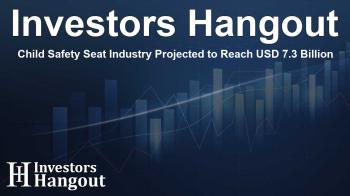Child Safety Seat Industry Projected to Reach USD 7.3 Billion

Overview of the Child Safety Seat Market Growth
The child safety seat market is experiencing noteworthy growth and is projected to reach USD 7.3 billion by 2032. Recent evaluations indicate that the market was valued at USD 4.4 billion in 2023, reflecting a substantial growth trajectory aided by significant factors such as enhanced parental awareness regarding child safety during travel, alongside stringent regulations mandated for child car seats.
Key Drivers Behind Market Expansion
Government interventions play a crucial role in this market's ascent. Enforced child car seat laws across numerous countries, particularly in developed nations, have escalated the demand for reliable and safe seating solutions designed specifically for children. This legal backing ensures that safety becomes paramount for parents, driving the market even further.
Technological Innovations
Technological advancements have also emerged as a critical propellant for market growth. Manufacturers are consistently innovating, developing child safety seats equipped with updated safety features that include side-impact protection systems, energy-absorbing materials, and adjustable headrests. These innovations not only enhance safety but also improve comfort, meeting consumer demand for products that cater to children from infancy through toddler years.
Product Types and Preferences
When looking at the different product types available, the market comprises various categories, such as combination seats, convertible seats, booster seats, and all-in-one seats. Among these, convertible seats emerged as the leaders in market sales in 2023, generating an impressive revenue of USD 1.7 billion. With a projected compound annual growth rate (CAGR) of 6.1% from 2024 to 2032, their popularity is attributed to their versatility, as they can seamlessly transition from rear-facing seats for infants to forward-facing seats for toddlers. This adaptability ensures prolonged usability at great value for parents.
Materials Impacting Market Values
The child safety seat market is also categorized by materials, which play a significant role in determining product characteristics and consumer choices. The materials segment consists of plastic, foam, steel, and other composites, with plastic dominating the market, accounting for 49.1% in 2023. The growth of plastic seats, projected at a CAGR of 6.1%, highlights their preference among consumers for properties such as durability and lightweight design, which are complemented by cost-effectiveness. Additionally, high-impact resistant materials like polypropylene are sought for their robust safety features in the event of collisions. Manufacturers can also mold plastic into various shapes, enhancing comfort while keeping production costs economical.
Trends in Market Demand
In the U.S. alone, the child safety seat market generated revenue of USD 762.6 million in 2023. Looking ahead, this segment is expected to witness a CAGR of 5.6%. Key elements include stringent regulations like the FMVSS 213 standards, which enforce the necessity of child safety seats for young passengers. Furthermore, public awareness campaigns and availability through major retail channels significantly contribute to the uptick in market demand.
Competitive Landscape
The child safety seat market features several prominent players such as Britax, Chicco, Clek, Cosco, Cybex, and Graco, among others, all competing to capture market share through innovation and improving customer satisfaction. The competitive environment is robust, with ongoing research and development aimed at enhancing product safety and user-friendliness.
Future Market Insights
The child safety seat market is on the brink of exciting developments, motivated by continuous growth in recognition of child passenger safety and evolving consumer expectations for advanced safety features. The industry also faces challenges, such as limited awareness in emerging markets and the high price points of cutting-edge safety seats, which could influence adoption rates. However, the market's potential remains distinguished, driven by avid demand for premium and multifunctional seating solutions.
Frequently Asked Questions
What is the projected value of the child safety seat market by 2032?
The child safety seat market is expected to reach USD 7.3 billion by 2032.
What are the key drivers of growth in this market?
Key drivers include increasing parental awareness of child safety and stringent governmental regulations concerning child car seats.
Which type of child safety seat is most popular?
Convertible seats are the most popular, with significant revenue generation due to their versatility and extended usability.
What material is most commonly used in child safety seats?
Plastic is the leading material used in child safety seats, favored for its durability and lightweight properties.
Who are some major players in the child safety seat market?
Major players include Britax, Chicco, Graco, Cosco, Cybex, and many others, competing for market share through innovation.
About Investors Hangout
Investors Hangout is a leading online stock forum for financial discussion and learning, offering a wide range of free tools and resources. It draws in traders of all levels, who exchange market knowledge, investigate trading tactics, and keep an eye on industry developments in real time. Featuring financial articles, stock message boards, quotes, charts, company profiles, and live news updates. Through cooperative learning and a wealth of informational resources, it helps users from novices creating their first portfolios to experts honing their techniques. Join Investors Hangout today: https://investorshangout.com/
Disclaimer: The content of this article is solely for general informational purposes only; it does not represent legal, financial, or investment advice. Investors Hangout does not offer financial advice; the author is not a licensed financial advisor. Consult a qualified advisor before making any financial or investment decisions based on this article. The author's interpretation of publicly available data shapes the opinions presented here; as a result, they should not be taken as advice to purchase, sell, or hold any securities mentioned or any other investments. The author does not guarantee the accuracy, completeness, or timeliness of any material, providing it "as is." Information and market conditions may change; past performance is not indicative of future outcomes. If any of the material offered here is inaccurate, please contact us for corrections.
